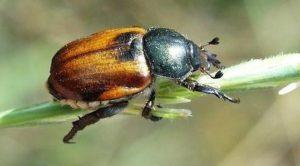Bread beetle Kuzka: eater of cereal crops
Cereal crops are considered the most valuable in agriculture. Cultivation is treated with special attention. However, there are pests that can cause great damage to plants. Kuzka beetle is one of such representatives.
Content
What does the Kuzka beetle look like: photo
Description of the beetle
Name: Bread beetle, Kuzka grain, Kuzka sowing
Latin: Anisoplia austriacaClass: Insects - Insecta
Squad: Coleoptera - Coleoptera
Family: Lamellar - Scarabaeidae
 | Habitats: | subtropics and tropics, everywhere |
 | Dangerous for: | cereals |
 | Means of destruction: | chemicals, biologicals, natural enemies |
The Kuzka beetle is similar to the May beetle. The insect belongs to the Coleoptera order and the Lamellar family. The shapes of the bodies with the cockchafer are identical. The size varies from 10 to 16 mm.
The body and head are black. Elytra brown or yellow-red. The edges are dark brown in color. Female individuals with a small black speck in the form of a triangle.
There are gray hairs on the limbs. With their help, insects cling to spikelets. Head with antennae, on which there are flat plates resembling a fan. Females are different from males. In females, the forms are rounded, while in males there are hook-shaped claws on the forelimbs.
Kuzka beetle prefers hot and sunny days. At night, they hide in cracks in the ground. The insect sleeps for a long time. Get out of the shelter after 9 o'clock in the morning.
Life cycle
Mating begins 14 days after the departure of the insects. There are 2 times more females than males.
For laying eggs, females penetrate into the ground about 15 cm deep. Laying occurs 2 or 3 times. Each clutch consists of 35-40 eggs. For 3 times the number can be more than a hundred. After the end of the process, the female dies.
Eggs are white matte oval. They are covered with a dense leathery shell. Egg size up to 2 mm. Eggs mature within 21 days. The destructive factors in this process are considered high humidity or excessive drought.
The larvae are white. As they mature, they become darker. Shedding occurs at the end of summer. The larvae live in the soil. The depth of immersion is affected by the level of moisture and temperature conditions. In spring and autumn, they can be found near the surface of the earth. During drought or frost, they are placed at a depth of about 30 cm. In areas with a cold climate, they burrow to 70-75 cm.
Small larvae feed on small roots or rotting plant debris. The larval stage lasts 2 years. For pupation, the larvae need an oval shelter. They make it at a depth of 15 cm. During this period, they are very afraid of light and temperature fluctuations.
Within 21 days, the pupae mature. Juveniles with soft elytra and delicate cover. The first few days they are in the soil to get stronger. Later they get out of the ground.
Habitat
Habitat - Asia and Europe. The largest populations can be found in the southern part of the Russian Federation, Western Europe, Hungary, Italy, Siberia, Asia Minor, and the Balkan Peninsula.
In the CIS countries, a huge number was noted in such areas as Yekaterinoslav, Podolsk, Kherson, Kharkov.
Recently, the Kuzka beetle has conquered the northern regions - the Caucasus, Transcaucasia, Vladimir, Saratov, Kazan regions.
Kuzka beetle diet
Diet of adults consists of barley, rye, wheat, grains of wild cereals. Adult beetles and larvae feed on cereals. One individual is able to destroy from 9 to 11 spikelets. This is about 175-180 grains. Beetles not only eat grains, but also knock them off spikelets.
Larvae more voracious. In addition to cereals, they feed on roots:
- beetroot;
- tobacco;
- carrots;
- corn;
- potatoes;
- sunflower.
Methods of struggle
Prevention of the appearance of a beetle
Some substances are used in seed treatment before sowing. But this does not give a 100% result. Soil disinfection cannot be done. Only with the help of regular plowing of the land can eggs with larvae be eliminated. In the fight against the kuzka beetle you must:
- carry out inter-row tillage;
- harvest as early as possible;
- apply insecticides;
- carry out early plowing.
Conclusion
The Kuzka beetle is as dangerous a pest as the Colorado potato beetle. It is the most dangerous enemy of cereal crops. When a pest appears, it is necessary to immediately proceed to plant protection.
Previous
